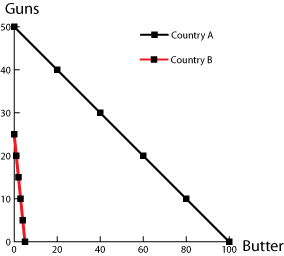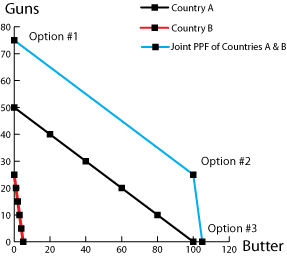|
|
| ||
Comparative Advantage
Comparative advantage is a condition of a producer where it is better suited for production of one good than another good. Good A can be produced more efficiently than good B, for example. This comparison is done in terms of opportunity costs of each good, not in terms of pure production costs. Opportunity cost is how much you can produce of the good B with the same amount of labor, capital, and other resources that it takes to produce one of good A. This is the tradeoff- how much of good B must be sacrificed in order to get one more of good A. An example is in order.
Example: Countries A & B
Consider two countries: Country A and Country B. Their economies consist entirely of guns and butter. Country A has an absolute advantage in the production of both goods, seeing as they can produce both more efficiently than Country B. Country A is thereby able to produce more of both goods. This is reflected on their production possibilities frontiers, where each country can either produce all guns or all butter or some combination of the two goods. This curve reflects their differing opportunity costs for each country. This is the tradeoff that occurs when you produce one good, and you can't use those same resources to produce a certain amount of another good. This cost is usually measured in terms of how much it costs to produce each product, or just the labor costs that it takes. To simplify it in this case, let's measure opportunity cost in the terms of how much of the other good is given up. The following table shows the individual production possibilities of country A and country B assuming autarky , or no trade at all. All of these tables assume daily production limits.
| Guns per day | Butter per day | |
| Country A | 50 | 100 |
| Country B | 25 | 5 |
This is an either/or production, in that either Country A can produce 50 guns in a day or it can produce 100 pounds of butter in a day. But this isn't the only option for A, as they can also produce any mix of the two goods that still has the same proportion. For instance, Country A could produce as each of these good mixes represent the same tradeoff. But the numbers in the table represent the highest production combinations by one country. As you can see in the following tables, any other combination would result in each country producing less efficiently by not focusing on their most productive good.
| Country A
| Country B
|

In order to determine if comparative advantages exist between the two countries, you have to figure out the opportunity cost of making one unit of one of the items. For Country A, for every 1 gun that they make they have to give up 2 lbs. of butter. And for every pound of butter that Country A produces they must give up 1/2 of a gun. For Country B, in order to make 1 gun they must give up the production of 1/5 lbs. of butter. And for every pound of butter they produce, they must give up on producing 5 guns. From this we can see that Country A has a comparative advantage in the production of butter and Country B has a comparative advantage in producing guns. Their opportunity costs are lower for each of these products relative to one another, and so there is potential for beneficial trade.
Comparative Advantage and Trade
Now consider when the two countries trade and observe how the resulting joint possibilities are larger.
| Description of the Option's Production Choices | Guns | Butter | Total Product | |
| Option #1 | Both countries produce maximum # of guns | 75 | 0 | 75 |
| Option #2 | Both countries focus on their efficient specialization | 25 | 100 | 125 |
| Option #3 | Both countries produce maximum amount of butter | 0 | 105 | 105 |

In Option #1 Country A contributes 50 guns and Country B produces 25 guns. In Option #3 Country A contributes 100 lbs. and Country B contributes 5 lbs. of butter. Both of these options are socially inefficient as one country isn't focusing on their comparative advantage in either case. Option #2 is the best choice as it maximizes production and utility for both countries because each country produces the item in which they have a comparative advantage, allowing them to receive benefits from trade. Country A produces 100 lbs. of butter while Country B supplies 25 guns. This is a hypothetical situation. In a more realistic scenario, Country B will produce exclusively or primarily guns and trade them for butter from Country A in a barter system. Country A would do the exact opposite, producing butter and trading its excess supply for any guns it wanted from Country B and didn't produce on their own.
This exemplifies the principle of comparative advantage, which holds "as long as the relative opportunity costs of producing goods differs among countries, there are potential gains from trade"(Colander, 406). Country A and Country B can specialize in which good has the least opportunity cost for them, using their resources in the most efficient manner. They can then trade with their specialized goods for other countries' products of specialization. This potential for mutually beneficial trade holds even if one country has an absolute advantage in all goods. As long as the more efficient country has a comparative advantage in the production of one good, there has to be another country that has a comparative advantage in the production of another good.
Back to Production Possibilities
Cited Source: Colander, David C. "Economics." 4th Ed. 2001. Irwin/McGraw-Hill, NYC
| Copyright 2006 Experimental Economics Center. All rights reserved. | Send us feedback |



